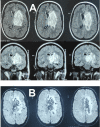Haemorrhagic encephalitis in the garb of scrub typhus
- PMID: 32859623
- PMCID: PMC7454241
- DOI: 10.1136/bcr-2020-235790
Haemorrhagic encephalitis in the garb of scrub typhus
Abstract
A 19-year-old girl presented with fever, headache, vomiting and drowsiness. She had grade 1 papilloedema and neck rigidity but no focal deficits or seizures. Cerebrospinal fluid analysis revealed lymphocytic pleocytosis, slightly elevated protein and normal glucose. MRI of the brain showed a hyperintense lesion in left ganglio-capsular region on the fluid attenuation inversion recovery sequence with perilesional oedema and mild midline shift. Haemorrhage was seen in the region on susceptibility weighted imaging . The patient was thoroughly investigated for known causes of meningoencephalitis, but the diagnosis of scrub typhus was delayed till the 10th day of illness. She was treated with doxycycline for 2 weeks and had marked improvement, both clinically and radiologically. Literature review has revealed that although meningoencephalitis in scrub typhus is not uncommon, such atypical lesions on brain MRI are a rarity. Serial imaging was performed to document the disease progression and resolution on treatment.
Keywords: infection (neurology); infectious diseases; tropical medicine (infectious disease).
© BMJ Publishing Group Limited 2020. No commercial re-use. See rights and permissions. Published by BMJ.
Conflict of interest statement
Competing interests: None declared.
Figures




Similar articles
-
Scrub typhus with cerebral venous sinus thrombosis: a rare presentation.BMJ Case Rep. 2021 Apr 28;14(4):e241401. doi: 10.1136/bcr-2020-241401. BMJ Case Rep. 2021. PMID: 33910803 Free PMC article.
-
Meningitis due to scrub typhus: the importance of a differential diagnosis in an endemic area.BMJ Case Rep. 2018 Apr 13;2018:bcr2018224499. doi: 10.1136/bcr-2018-224499. BMJ Case Rep. 2018. PMID: 29654106 Free PMC article.
-
Hemorrhagic Transformation of Scrub Typhus Encephalitis: A Rare Entity.Clin Neuroradiol. 2015 Dec;25(4):415-8. doi: 10.1007/s00062-014-0348-9. Epub 2014 Nov 6. Clin Neuroradiol. 2015. PMID: 25373351
-
ACUTE CHOLECYSTITIS AS AN UNUSUAL PRESENTATION OF SCRUB TYPHUS: A REPORT OF TWO CASES AND REVIEW OF THE LITERATURE.Southeast Asian J Trop Med Public Health. 2017 Jan;48(1):143-9. Southeast Asian J Trop Med Public Health. 2017. PMID: 29644830 Review.
-
Scrub typhus and antibiotic-resistant Orientia tsutsugamushi.Expert Rev Anti Infect Ther. 2021 Dec;19(12):1519-1527. doi: 10.1080/14787210.2021.1941869. Epub 2021 Jun 21. Expert Rev Anti Infect Ther. 2021. PMID: 34109905 Review.
Cited by
-
Clinical treatment of patients with scrub typhus-induced liver injury and intracranial infection.J Int Med Res. 2023 Nov;51(11):3000605231214503. doi: 10.1177/03000605231214503. J Int Med Res. 2023. PMID: 38008898 Free PMC article.
-
Neurological Facets of Scrub Typhus: A Comprehensive Narrative Review.Ann Indian Acad Neurol. 2021 Nov-Dec;24(6):849-864. doi: 10.4103/aian.aian_739_21. Epub 2021 Dec 17. Ann Indian Acad Neurol. 2021. PMID: 35359522 Free PMC article.
-
Scrub typhus with hemorrhagic stroke: a case report.J Med Case Rep. 2024 Jul 27;18(1):343. doi: 10.1186/s13256-024-04667-0. J Med Case Rep. 2024. PMID: 39061090 Free PMC article.
References
Publication types
MeSH terms
Substances
LinkOut - more resources
Full Text Sources
Medical
